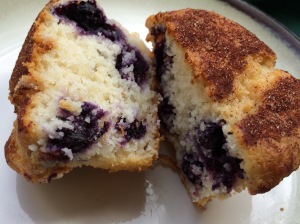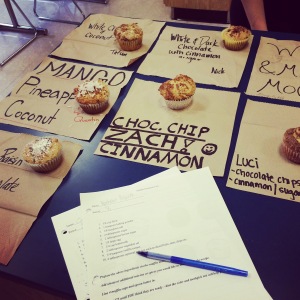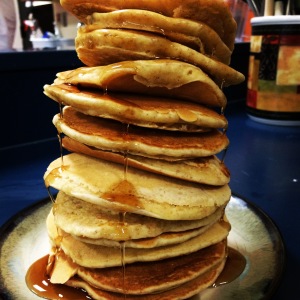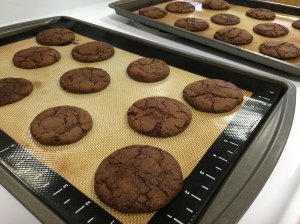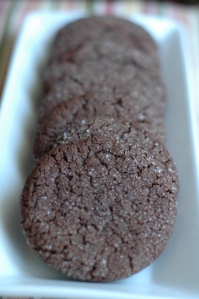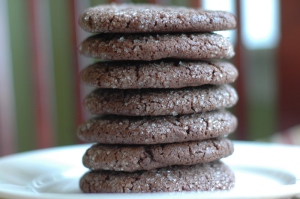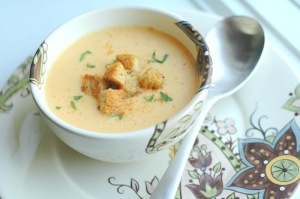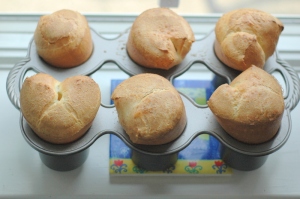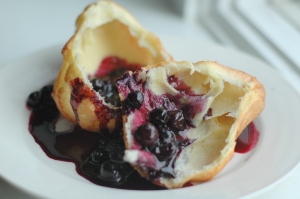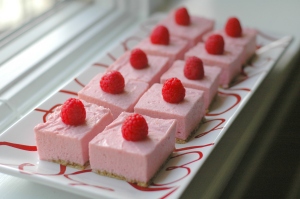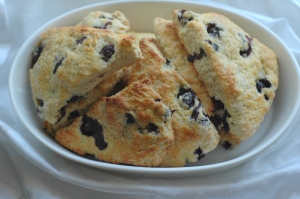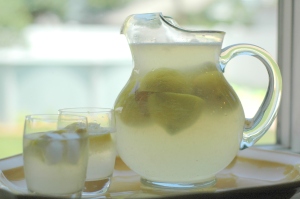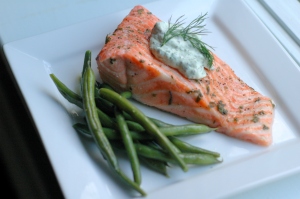
People always ask me what my favorite meals are and where I like to eat. Although there are a few places I like to go out to, most of my favorite dishes are ones made by friends and family. One of the most memorable things I have had in a long time is this recipe from my Aunt’s friend Sam, that he brought to her 4th of July party. Like an episode of the Food Network’s “The best thing I ever ate”, I couldn’t stop talking and thinking about this salmon for weeks after I had it. It was a beautiful whole salmon, steamed over a flavorful liquid and accompanied by a fresh, bright mango salsa. It was plated with a trio of different dipping sauce options and served cool. I ate my weight in salmon that day and even at night, when everyone else had switched to dessert before the fireworks, I was stealing more from the fridge instead of ice cream.
Although I was able to get the recipe from Sam awhile ago, life has been busy and I have yet to share it with you. I decided to share it with you tonight, because unfortunately, I found out that Sam has been sick in the hospital and needs to have surgery tomorrow. I hope you enjoy this recipe as much as I do, and that you say a prayer that he has a quick recovery and can share more great recipes with us as soon as possible.
Salmon and Mango Salsa – served with Dill, Chipotle Pepper and Honey Mustard dipping sauces
In Sam’s Words exactly:
Select a salmon fillet to suit your taste and of a size to fit your need. If you don’t have a poaching pan ( an asparagus cooker works very well too), you can use a deep frying pan as long as you use a wire rack so the salmon does not rest in the liquid. In the bottom of the pan, place a mix of 1 cup of water to 2 cups of white wine. I prefer Sauvignon Blanc or a similar white wine of full body and taste.
Rub the salmon with salt, white pepper and bit of finely minced tarragon and place on a rack in the pan so the salmon is not resting in the liquid. Over medium heat, cover the pan and steam/poach the salmon fillet.

Once the liquid begins to boil, continue cooking for about 10 minutes, depending on the size and thickness. When cooked through, turn off the heat and allow to cool to room temperature with the cover on. Place in the refrigerator for 3 hours or up to a day to cool completely.
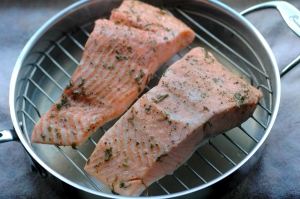
Remove from rack and surround it with mango salsa.
Mango Salsa
2-3 ripe mangoes, diced small
1/2 red onion, finely diced
2-3 tablespoons cilantro, finely chopped
the juice of 2-3 limes, freshly squeezed
2 tablespoons orange juice, freshly squeezed
freshly ground salt and pepper to taste
Combine all ingredients in a bowl and mix. Season with salt and pepper. Allow to stand at least one hour or up to a day to allow the flavors to blend.
Note- this also works out very well with using ripe papaya, pineapple or guava.
Dill Sauce
In a bowl, combine 6 oz sour cream with 1 tablespoon of mayonnaise. Finely chop a handful of fresh dill and add to sour cream. Mix in 1 teaspoon Dijon mustard. Mix by hand rather than in a food processor otherwise it becomes runny. Refrigerate at least 2 hours.
Chipotle Sauce
In a bowl, combine 6 oz sour cream with 1 tablespoon of mayonnaise. In a food processor finely chop a chipotle pepper ( canned in adobo sauce ) with 2-3 tablespoons of the sauce from the can. Add to sour cream mixture. Refrigerate at least 2 hours.
Honey mustard sauce
In a bowl, combine 6 oz sour cream with 1 tablespoon of mayonnaise. Add 5-6 tablespoons Dijon mustard ( smooth, not with mustard seeds) and 3-4 tablespoons honey. Mix in 4 tablespoons freshly squeeze lime juice. Refrigerate at least 2 hours.
Thank you Sam and get better soon!

